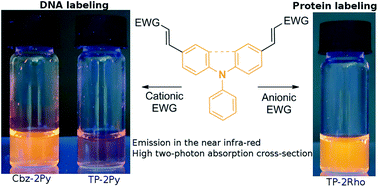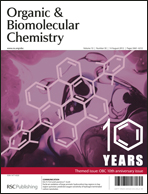Vinyl-triphenylamine dyes, a new family of switchable fluorescent probes for targeted two-photon cellular imaging: from DNA to protein labeling†‡
Abstract
On the basis of our previous work on vinyl-triphenylamine derived DNA fluorophores we explored the structure space around this core by coupling it to diverse cationic, anionic and zwitterionic groups in the aim of targeting different classes of biomolecules. In parallel core modifications were performed to optimize the photophysical properties (quantum yield, two-photon absorption). The resulting water soluble π-conjugated molecules are called TP dyes and display an exceptional combination of optical properties: high two-photon absorption cross-section, high photostability, no self-quenching, and switchable fluorescence emission when bound to a biopolymer matrix. The linear and nonlinear optical properties of the TP dyes were studied in vitro in presence of DNA and in presence of a model protein (human serum albumin) using complementary absorption and fluorescence spectroscopy characterization tools. Structure modifications enabled to switch from DNA probes (cationic TP-pyridinium series) to protein probes (anionic TP-rhodanine series) without affecting the optical properties. Finally most TP compounds appear cell-permeant and show an intracellular localization consistent with their in vitro target specificity.

- This article is part of the themed collection: Organic & Biomolecular Chemistry 10th Anniversary

 Please wait while we load your content...
Please wait while we load your content...